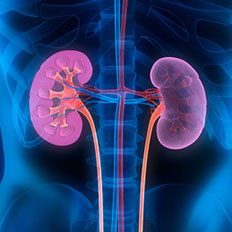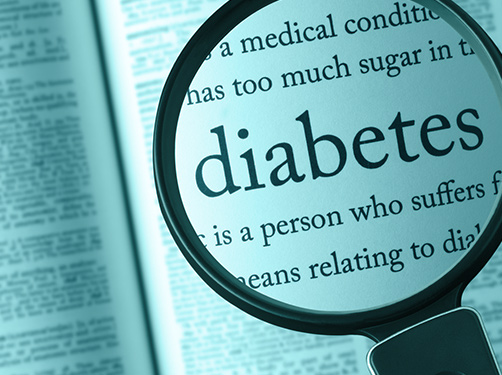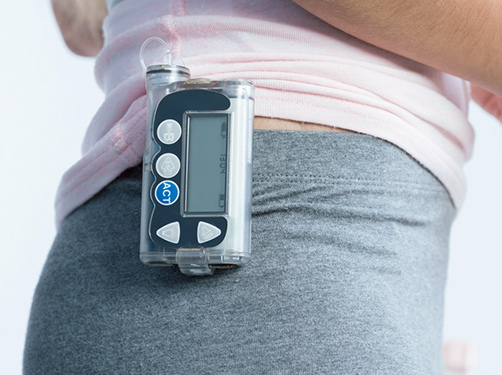Diabetic nephropathy: How diabetes affects the kidneys
Scientific support: Prof. Dr. Karsten Müssig, Prof. Dr. Karin Jandeleit-Dahm
The term diabetes-associated nephropathy or kidney disease encompasses all damage to the kidneys in people with diabetes. A distinction is made between
- kidney disease caused directly by diabetes, known as diabetic nephropathy, and
- kidney damage that can be traced back to other causes, e.g., elevated blood pressure or kidney disease not related to diabetes.

How does diabetes-related kidney disease develop?
Each kidney is made up of several sub-units. The small filtering units in the kidneys play an essential role in detoxifying the body and regulating water and salt levels. The renal corpuscles are comprised of a knot of fine capillaries through which all the blood in the body must pass. Very small substances, such as salts, urea, or residual contaminants, are filtered out of the blood by the vascular wall within the renal corpuscles and the excreted via the urine. Due to their size, larger substances, such as proteins and blood cells, generally don’t pass through the wall and remain in the body.
Good to know:
Early diagnosis and strict blood sugar and blood pressure management can help delay and sometimes even prevent kidney damage.
Long-term elevation of blood sugar levels can damage the walls of the fine blood vessels in the renal corpuscles. Holes begin to form and the vascular walls become more permeable, causing more protein to be excreted via the urine. These diabetes-related changes cause a deterioration in blood circulation and kidney function. Medical specialists refer to this situation as renal insufficiency.
Early diagnosis and consistent management of blood sugar and blood pressure levels have a positive effect on diabetes-induced kidney damage and can delay the progression of the disease. During the early stages, initial changes can be reversed, and, at times, maintained in the long-term. However, without the necessary therapeutic measures, kidney failure can occur in the worst-case scenario.
How can diabetic nephropathy be prevented?
A decisive factor in the prevention or delaying of diabetic kidney disease is blood sugar management. According to the current guidelines for kidney disease associated with adult-onset diabetes, the long-term sugar value (HbA1c) should be between 6.5 and 7.5 percent (48 to 58 mmol/mol) to help prevent nephropathy. This applies to both type 1 diabetes and type 2 diabetes. Patients who have already suffered damage to the medium and large blood vessels or who have difficulty recognizing the signs of low blood sugar should maintain a HbA1c level between 7.0 and 7.5 percent (53 to 58 mmol/mol).
Along with diabetes, elevated blood pressure is a significant risk factor for the onset of kidney damage. For this reason, drug-based treatment of the high blood pressure is necessary. For people with diabetes, a diastolic (lower) blood pressure value of 80 mmHg is recommended. The systolic blood pressure (upper value) should be strictly reduced to a value below 140 mmHg. However, similar to diabetes therapy, individual circumstances must be considered when setting target values for blood pressure management.
A healthy lifestyle is also essential for the prevention of diabetes-induced kidney damage:
- Try to be more active in everyday life and get enough exercise.
- Make sure you eat a balanced and fiber-rich diet. Try to keep your salt intake as low as possible and avoid energy-rich foods and drinks that contain unhealthy fats and free sugars (e.g., soft drinks, sweet snacks, and fatty processed meats).
Also, try to avoid drinking alcohol as much as possible. - Maintain a healthy weight.
- Don’t smoke.
Furthermore, there should be at least one annual assessment of renal function and albumin excretion levels in the urine. For patients with type 1 diabetes, this recommendation applies after 5 years with the disease. After being diagnosed, people with type 2 diabetes with no symptoms of nephropathy should undergo annual examination.
The risk factors for the onset of kidney disease can be divided into controllable and uncontrollable factors. Controllable factors include:
- Elevated blood sugar levels
- High blood pressure
- Increased protein intake
- Smoking
- Elevated blood lipids (cholesterol and triglycerides)
- Being overweight
Good to know:
Even moderate smoking damages health. Kidney damage progresses at twice the rate in moderate smokers compared to non-smokers.
Uncontrollable risk factors include:
- Old age
- Duration of diabetes
- Diabetes diagnosis under the age of 20
- Concurrent presence of retinal damage (retinopathy)
- Genetic predisposition (family history of high blood pressure and kidney disease)
A significant influencing factor for kidney damage associated with diabetes is blood sugar. Several long-term studies have shown that the early initiation of intensified diabetes therapy in people with type 1 diabetes and a long-term sugar value (HbA1c) of 6.5 to 7.5 percent (47.5 to 58.5 mmol/mol) significantly reduce the risk of impaired renal function. However, even in cases of advanced kidney damage in people with diabetes, well-managed blood sugar levels have a positive effect on the progress of the disease.
Along with good blood sugar management, effective reduction of blood pressure can notably reduce the progression of diabetes-related kidney disease. High blood pressure can be both a trigger for kidney damage as well as a consequence.
Diabetes-induced kidney damage tends to progress very gradually without pain or specific symptoms. It is often discovered during a recommended renal function examination or testing of the amount of albumin excreted via the urine.
Advanced renal insufficiency symptoms may only become noticeable after several years. These symptoms include:
- Itching
- Exhaustion, fatigue, and/or sleep disorders
- Reduced ability to function and concentrate
- Muscle cramps
- Increased water retention in the legs, feet, or eyes (edemas)
- Loss of appetite
- Nausea and vomiting
Determining albumin excretion
A possible sign of kidney disease is increased albumin excretion via the urine (albuminuria). If the kidneys are functioning normally, most of the albumin remains in the blood and only a very small amount (less than 20 milligrams per liter of urine) is excreted via the urine. Albumin excretion of 20 to 200 milligrams per liter of urine or 30 to 300 milligrams per day is known as microalbuminuria. Albumin levels exceeding 200 milligrams per liter of urine or 300 milligrams per day is known as macroalbuminuria.
Microalbuminuria can be a sign of early-stage diabetic kidney disease or kidney disease not associated with diabetes. In addition, increased excretion of albumin can also be a sign of other types of disease, for example, cardiovascular disease. If macroalbuminuria is identified, there is a high probability that there is an underlying kidney disease.
Albumin excretion is determined using a urine sample - ideally the first urine of the day. Because several factors, such as urinary tract infection, fever, and physical exertion, can influence the urine albumin concentration, testing is usually repeated several times. The “2 out of 3 rule” applies:
- The detection of elevated albumin levels in two consecutive urine samples is considered proof of albuminuria.
- If elevated albumin levels are not identified in two consecutive urine samples, then albuminuria is ruled out.
- If the first two urine samples show divergent findings regarding the albumin concentration, then a third urine sample should be sent for analysis.
Generally, the albumin-creatinine quotient in early morning urine is used to determine the amount of excreted albumin. Medical professionals also use the term albumin-to-creatinine ratio (ACR). The identification of an albumin-creatinine quotient of 30 milligrams per gram of creatinine in two consecutive urine samples within a three-month period indicates a high likelihood of diabetic nephropathy.
Determination of the glomerular filtration rate
Another parameter used to identify kidney damage is a reduced glomerular filtration rate. The glomerular filtration rate (GFR) is the measurement used to determine the filtration performance of the kidneys. The lower the glomerular filtration rate, the lower the amount of blood filtered per minute by the kidneys.
As kidney damage progresses, the glomerular filtration rate decreases further despite, although there is often an initial short-term hyperfiltration, i.e., an increased filtration rate, especially at the beginning of the developing diabetic nephropathy.
Good to know:
All people, with or without diabetes, suffer from a decrease in their glomerular filtration rate as they age.
The glomerular filtration rate can be indicated using the creatinine clearance rate or a mathematic estimation. Creatinine is a metabolic product of the muscles that is excreted exclusively via the kidneys. The creatinine clearance rate describes the measurement of the amount of creatinine filtered out of the blood and excreted via the urine within a certain time period.
The estimation of the glomerular filtration rate using a mathematic formula offers a rapid and reliable alternative to determining the creatinine clearance rate. The following parameters are required to calculate the estimated glomerular filtration rate (eGFR): Blood creatinine levels, gender, age and body weight of the patient.
Other diagnostics
When it is suspected that kidney damage is not associated with diabetes, the treating physician will order further laboratory testing and physical examinations to make a diagnosis. To further explore the potential diagnosis, in some cases, help will be sought from a nephrologist.
Based on the glomerular filtration rate, a distinction is made between 5 different stages of kidney damage associated with diabetes.
Stages | Estimated glomerular filtration rate (eGFR) | |
Stage 1 | Changes to the kidneys without any loss of function but with increased albumin excretion (microalbuminuria or macroalbuminuria) | 90 or higher |
Stage 2 | Kidney disease with low-grade function impairment and elevated albumin excretion (macroalbuminuria) | 60 to 89 |
| Stage 3 | Kidney disease with moderate-grade function impairment | 30 to 59 |
Stage 4 | Kidney disease with severe function impairment | 15 to 29 |
Stage 5 | Chronic kidney failure or permanent loss of function (terminal renal insufficiency) | under 15 |
Elevated albumin excretion and loss of renal function are also independent risk factors for cardiovascular disease and death.
Good blood sugar management and strict monitoring of blood pressure levels are the most important factors to prevent or delay the progression of diabetic kidney disease. Against this backdrop, the German Diabetes Association recommends a long-term blood sugar value below 7.0 percent (below 53 mmol/mol) as a therapeutic objective. This does not apply to patients who suffer from impaired awareness of low blood sugar levels (hypoglycemia) or who have already suffered damage to the medium and large blood vessels. The target HbA1c level for these patients should be determined by their treating physician based on their individual circumstances.
Due to their respective mechanisms of action on sugar metabolism and possible side effects, not all types of blood sugar-reducing drugs are similarly well suited to diabetes therapy. Several large studies identified the protective effects of gliflozins (SGLT-2 inhibitors) and GLP-1 agonists for the kidneys and cardiovascular system. They provide a therapeutic option if there are no intolerances or contraindications.
If it is no longer possible to use blood sugar-reducing tablets (known as antidiabetics) to ensure optimal blood sugar management in people with type 2 diabetes, then switching to insulin therapy can be beneficial. This also applies if the patient often suffers from episodes of low blood sugar or reduced overall well-being. Blood sugar-reducing tablets should only be used sparingly for the treatment of diabetes when the glomerular filtration rate is below 60 milliliter per minute (stage 3) and only with regular kidney function testing. Oral antidiabetics should not be used in cases of severe renal function impairment with a glomerular filtration rate below 30 milliliter per minute.
Nephrological co-assessment is required in cases of stage three kidney damage (moderate function impairment), rapid disease progression and kidney damage not associated with diabetes.
Renal replacement therapy is necessary if the kidneys are so severely damaged that it results in chronic renal failure. Renal replacement therapy encompasses all medical procedures used to replace the function of the kidneys. The most common procedure used to clean the blood is dialysis. Organ transplantation can also be carried out. If possible, people with type 1 diabetes receive both the kidney and the insulin-producing beta cells of the pancreas during a transplant. In contrast, people with type 2 diabetes generally receive only the kidney.
Along with blood sugar management, blood pressure management plays an important role in the treatment of diabetic kidney disease. High blood pressure increases the risk of further kidney damage and the onset of cardiovascular disease. For this reason, elevated blood pressure requires drug-based therapy. ACE inhibitors and angiotensin II receptor antagonists (AT1 blockers) are especially suited to this type of treatment.
People with diabetes should aim for a target blood pressure level of 130/80 mmHg or lower but not below 120/70 mmHg. For people with diabetes and high blood pressure aged 65 and above, an upper (systolic) blood pressure level of 130 to 140 mmHg is recommended.
The following therapeutic measures should be taken into account to prevent the progression of kidney disease:
- Reduce the protein content of food to 0.8 grams per kilogram body weight per day
- Avoid radiocontrast agents
- Treat urinary tract infections using antibiotics
- Avoid the use of certain types of medication (non-steroidal anti-inflammatory drugs and mixed analgesics)
- Adapt medication dosages to the impaired renal function
- If possible:
- Stop smoking
- Lose weight
- Drug-based treatment of elevated blood lipid levels or existing cardiovascular risk factors
Because impaired renal function increases the risk of further complications of diabetes, especially those affecting the eyes and cardiovascular disease, appropriate check-ups should take place at least yearly.
The incidence of diabetic nephropathy is approximately 20 to 40 percent for people with diabetes. According to studies, 42 out of 100 people with type 2 diabetes have impaired renal function. This makes diabetic kidney disease one of the most common complications of diabetes. In industrialized countries, diabetes is the most common reason for chronic kidney failure and dialysis dependency.
Sources:
American Diabetes Association: Microvascular Complications and Foot Care: Standards of Medical Care in Diabetes – 2019. In: Diabetes Care, 2019, 42: S124-S138
Bundesärztekammer et al.: Nationale Versorgungsleitlinie Nierenerkrankungen bei Diabetes im Erwachsenenalter. Langfassung. 1. Auflage. Version 6. 2015
Bundesärztekammer et al.: Patientenleitlinie zur Nationalen Versorgungsleitlinie Nierenerkrankungen bei Diabetes im Erwachsenenalter. Version 1.0. 2012
Deutsche Diabetes Gesellschaft: S3-Leitlinie Ernährungsempfehlungen zur Behandlung und Prävention des Diabetes mellitus – Empfehlungen zur Proteinzufuhr. Version 1.0. 2015
Deutsche Diabetes Gesellschaft et al.: Deutscher Gesundheitsbericht Diabetes 2019. Kirchheim Verlag, Mainz, 2019
Drawz, P. et al.: Chronic kidney disease. In: Ann Intern Med, 2015, 162: ITC1-16
Merker, L. et al.: Nephropathie bei Diabetes. In: Diabetologie, 2018, 13: S217-S220
As of: 29.04.2021






